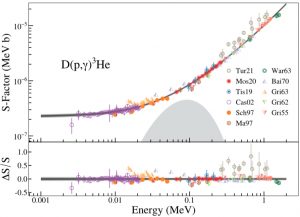Big bang nucleosynthesis (BBN) is the standard model theory for the production of light nuclides during the early stages of the universe, taking place about 20 minutes after the big bang. The synthesis of deuterium is an essential reaction after the universe cooled and is consumed in nucleosynthesis processes of helium-4. Deuterium production, in particular, is highly sensitive to the primordial baryon density and the number of neutrino species. Its abundance serves as a sensitive test for the conditions in the early universe. The comparison of observed deuterium abundances with predicted ones requires reliable knowledge of the relevant thermonuclear reaction rates and their corresponding uncertainties. Recent observations reported the primordial deuterium abundance with percent accuracy, but some theoretical predictions based on BBN are in tension with the measured values because of uncertainties in the cross section of the deuterium-burning reactions.
In this work, Moscoso and colleagues analyzed the S-factor of the D(p,gamma)3He reaction using a hierarchical Bayesian model. The S-factor is a measure of the cross section of the process that takes into account the Coulomb repulsion of the nuclei. The reaction of D(p,gamma)3He has a much higher uncertainty at the BBN relevant energy than the other relevant processes, making it necessary to improve upon it for BBN studies. They considered the results of 11 experiments, spanning the period of 1955–2021, more than any other study. They also present results for two different fitting functions, a two-parameter function based on microscopic nuclear theory and a four-parameter polynomial. Our recommended reaction rates have a 2.2% uncertainty at 0.8 GK, which is the temperature most important for deuterium BBN. They conclude with a comparison of our S-factor fit and confirming the tension between the predicted and observed primordial deuterium abundance and its hinting at physics beyond the standard model!

The figure shows our Bayesian S-factor fit to the data. The two-parameter fit function was S(E) = (scale factor) × S_theory + (offset) MeVb, where S_theory denotes the theoretical S-factor calculated using a microscopic nuclear theory model. The dark- and light-gray-shaded bands correspond to 68th and 95th percentiles, respectively, of the predicted S-factor. The gray-shaded region shows the Gamow peak at a temperature of T = 0.8 GK. Residuals of fit or data with respect to the median (50 percentile) S-factor at each energy are depicted in the bottom panel. Our fit represents the most reliable estimation of the D(p,gamma)3He S-factor to date. For more information, see Moscoso, de Souza, Coc & Iliadis, Astrophys. J. 923, 49 (2021).
This project was supported by the National Science Foundation’s Graduate Student Fellowship Program.

